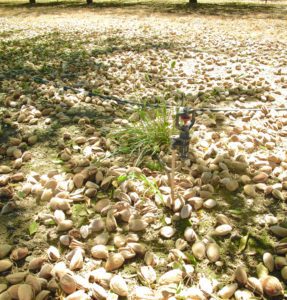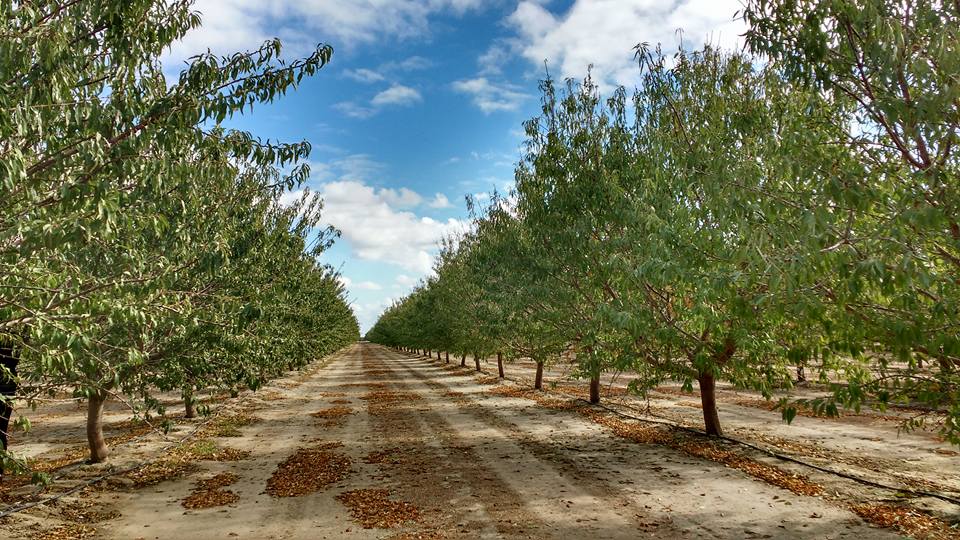Subsurface drip irrigation in almonds may not be the way to go for all growers in the state, but for two almond operations, Terranova Ranch in Fresno County and 4R Farming in Arbuckle, the practice has proven to be very successful.
The use of subsurface drip irrigation (SDI) is nothing new on a worldwide level. In Israel the practice has been around since the 1960s. SDI has had many diverse uses around the world for a multitude of crops on multiple soil types in various climates.
Here in the United States, studies and research into SDI, its advantages and disadvantages, continues, as is education on the system and commercial activities.
SDI is a system that provides a low-pressure water source to almonds, and other crops, through buried drip tape or hard tubing with built-in emitters.
Terranova is a diversified farm that grows more than 20 crops per season on roughly 7,500 acres, of which nearly 1,000 is in almonds in the varieties of Nonpareil, Monterey, Butte, Carmel, Wood Colony, Aldrich and Independence.
Patrick Pinkard, ranch assistant manager in charge of farming operations, said for nearly two decades they have been using SDI in their row crops and have been so well pleased with the results they are transitioning young almond plantings into SDI this year.
Terranova General Manager Don Cameron was among an agricultural delegation from California who made a trip to Israel last year for the purpose of learning more about the Middle Eastern county’s efficient irrigation practices, such as SDI, and other successful growing innovations.
Gerry Rominger, owner of 4R Farming, said his family has been farming in Yolo and Colusa counties since 1870. “Of the 2,900 farmed acres, 2,400 are planted in almonds,” he added. “The farm began subsurface drip irrigation in the orchards in 2004. Every orchard planted since then has had buried drip tubing as the sole irrigation system.
To prepare for the use of SDI, all of Rominger’s orchards are laser levelled before planting.
“The orchards are planted on 24 foot x 16 foot spacing and the SDI tubing is buried 12 inches deep and six feet out from the tree row,” he explained. “Emitters are .5 gallons per hour at 40 inch spacing.”
For the first year of planting, Rominger uses surface tubing irrigation, then buried tubing is installed and used thereafter.

SDI advantages
Pinkard said with the use of SDI, Terranova has seen higher yields with significant reduction in water usage.
“We would like to convert more of our orchards the next few years and get the ranch using the least amount of water possible to continue farming in the future,” he stated.
Several studies have shown soil evaporation, surface runoff, and deep percolation are greatly reduced or eliminated with SDI.
With the use of SDI, Rominger said his operation saw a “substantial crop yield increase,” which he feels off-sets the additional cost of the system.
According to Pinkard, another benefit the ranch will see with the subsurface drip in almonds is better harvesting conditions.”
“With the subsurface irrigation tape buried you will no longer run into a sweeper hitting the drip hose or ever having to move the hose. It will also decrease the germination of weed seeds, as less water is brought up to the surface,” he explained.
Additional advantages both growers have observed is less frequent leaks with the irrigation tubing or hose not being exposed to the elements, equipment, and both two-legged and four-legged critters.
Rominger has found less herbicide use is required with SDI as there is less of a weed problem.
Because there is less of a weed problem, mowing and the costs associated with mowing is reduced.
“We are also able to irrigate during windy conditions and there is minimal hand raking during harvest,” he said.
Studies have found with SDI runoff into streams is reduced or eliminated, and there is less nutrient and chemical leaching due to deep percolation.
Other benefits of SDI include design flexibility, system longevity in some cases, placing water right where the roots are, the ability to irrigate during harvest, and a dry orchard floor helping to prevent surface diseases.
Research at Kansas State University with Dr. Freddie Lamm found damage to almonds drying on the surface during harvest when irrigation may be required is eliminated with SDI.
SDI disadvantages
At the Terranova Ranch, Pinkard has found one drawback to SDI is plugging of emitters which are below surface and more difficult to replace than surface drip systems or equipment on micro sprinklers.
Rominger agrees, “Extra care is required to avoid emitter plugging.”
Growers can address this problem by selecting trifluralin-impregnated emitters or by trifluralin applications through the system, according to Larry Schwankl, retired irrigation specialist, University of California Cooperative Extension (UCCE). A large scale, 10-year field trial conducted at the Nickels Soils Laboratory found no significant root intrusion was found in trifluralin impregnated SDI emitters, but standard SDI emitters were plugged by almond root growth after five years of field operation.
Installation cost is another disadvantage.
SDI can have a high initial investment cost compared to some other irrigation systems, but some growers, such as Rominger, believe that investment pays off in the end with higher crop yields and less water usage.
Rodents, such as gophers, can cause damage to the system by chewing on it.
Clogging can be a problem from buildup of minerals and algae. Cleanout valves installed at the end of the tube lines are important to remove blockages and draining the system.
Root intrusion and pinching off by roots can be another problem, all of which growers can’t see until damage becomes evident in the tree or vegetation around it.
The lack of visual indicators of proper irrigation performance is a major disadvantage with SDI, Schwankl said.
Because of this, growers believe they need to use more sophisticated and costly management procedures with SDI.
Rominger said irrigation management requirements do increase with SDI compared to surface drip systems, but again, he feels the end results are worth it.
“Buried tubing in almond orchards is not for all soil types or land terrain,” Rominger said.
Soils with low infiltration rates pose a challenge for subsurface irrigation and drip tube spacing needs to be adjusted for clay-type soils.
Is SDI an option
For some growers considering implementation of SDI many questions stand out—such as, what is the best equipment to use; how to custom design the system; is an orchard’s soil and terrain receptive to SDI; how long will the system last; is financing available to purchase all that is required for a SDI system, and so forth.
Another consideration is whether or not conversion to SDI from a currently used irrigation system is possible. According to Schwankl, it can, and has been, done.
Time, experience and research have proven that proper installation of a SDI system is critical to maximizing the system benefits and long term stability.
The performance and life of any system depends on how well it is designed, operated and maintained. Whether automatically controlled or otherwise, inspection of SDI systems must be made often and on a regular scheduled basis for the best bang for the buck.
Growth of SDI in almonds is expected to increase as system design is improved, disadvantages are remedied, and better and more failsafe operational and management procedures are developed.
















